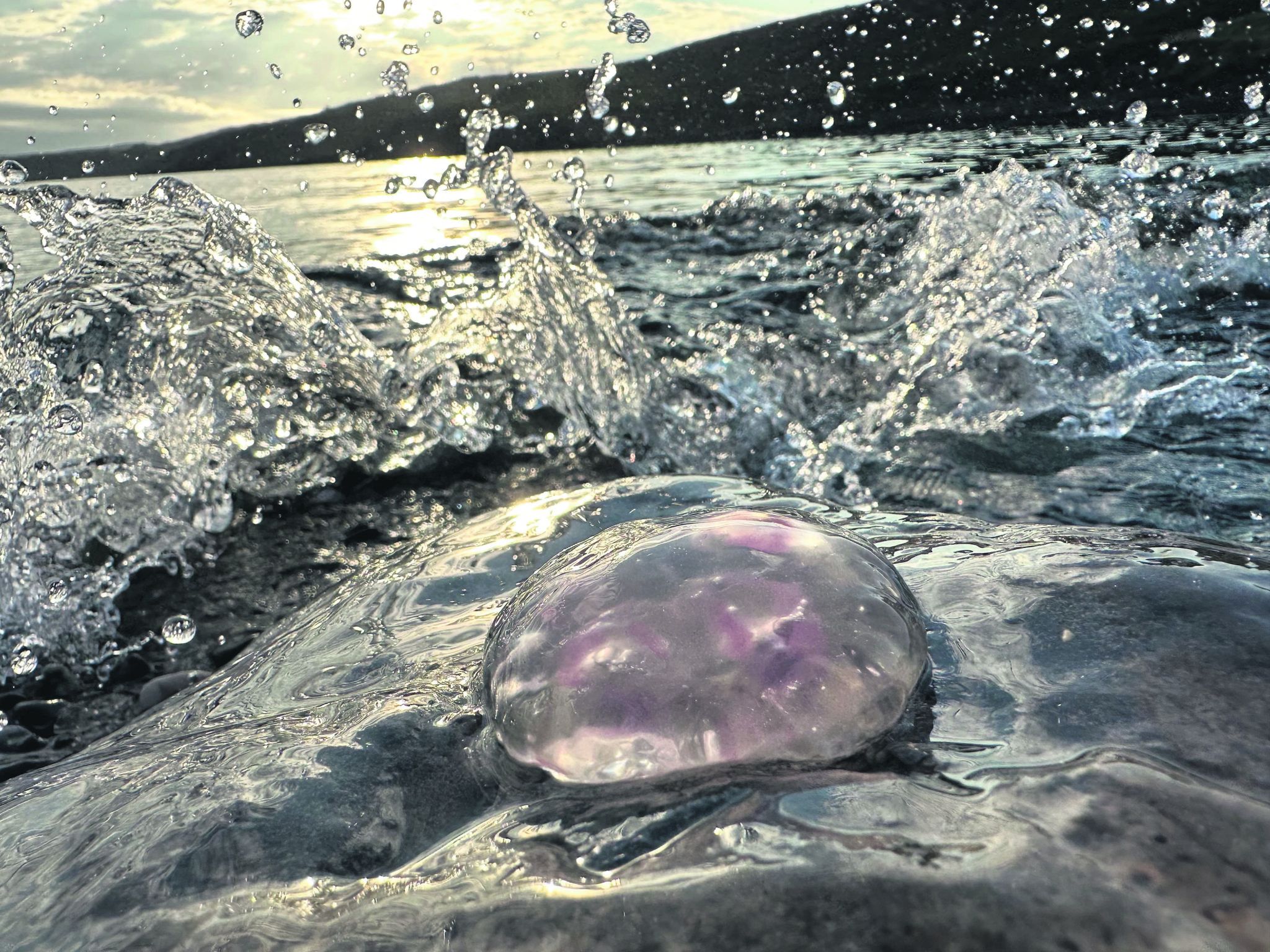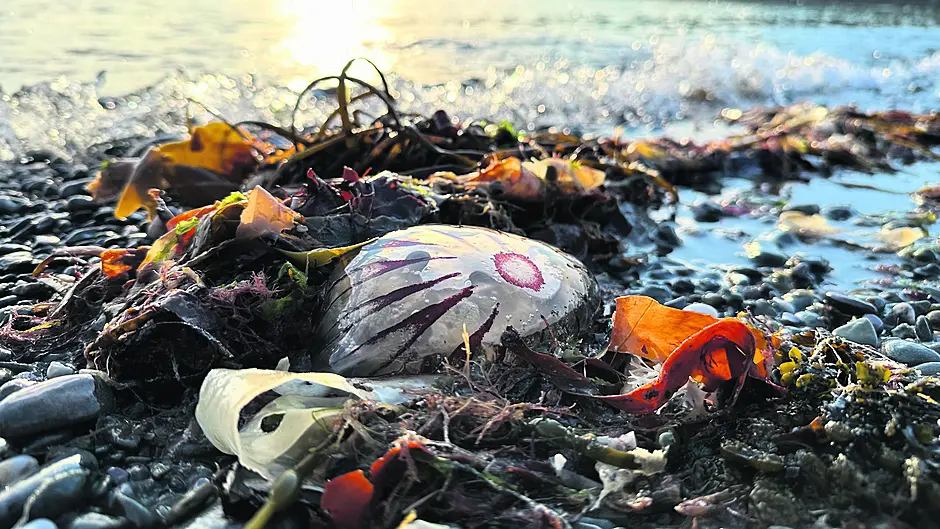BY ANN HAIGH
LIVING in West Cork, we are incredibly fortunate that we can head to a beach for a swim.
Unfortunately, the dread of a jellyfish sting tends to strike fear into the hearts of many over the summer months.
As the saying goes, the fear of the unknown is the worst fear of all, so this week let’s get to know jellyfish a little bit better. Have you ever wondered what and how they eat, what their lifecycle is and indeed why they even exist? Read on to get to grips with everything jellyfish!
Our jelly friends
First things first, jellyfish have been around a lot longer than humans. Homo sapiens, modern humans, only evolved around 200,000 to 300,000 years ago, yet records show that jellyfish have roamed the seas for over 500 million years. If it was on a first-come first-served basis, we would have little claim to our local beaches.
Jellyfish are animals in the cnidarian group, which also contains sea anemones and corals. Lacking organs such as a heart or brain, they comprise up to 96% water with the remainder being collagen and various proteins. Without lungs, they manage to get sufficient oxygen into their body via diffusion through their epidermis or ‘skin’. To achieve movement most jellyfish can contract and move their fluid composition in a pulsating fashion which allows them to propel through water.
 Moon jellyfish at Toe Head. Moon jellyfish can be found around the entire island and are our most prevalent. They are easily recognised by their transparency and four pink rings in the centre. Despite having tiny tentacles most people do not get a reaction from their sting. (Photo: Ann Haigh)
Moon jellyfish at Toe Head. Moon jellyfish can be found around the entire island and are our most prevalent. They are easily recognised by their transparency and four pink rings in the centre. Despite having tiny tentacles most people do not get a reaction from their sting. (Photo: Ann Haigh)
The sting
Jellyfish do not seek us out to sting and stinging humans is purely accidental or defensive. On each jellyfish tentacle there are thousands of tiny stinging capsules known as nematocysts. Each of these have a microscopic needle-like tube coiled up inside. When triggered, the tube straightens up and is fired out of the capsule and injects venom into whatever it is in contact with.
Most jellyfish are carnivores and feed on zooplankton, crustaceans, small fish, fish eggs, larvae, and other jellyfish. They ensnare prey in their tentacles, use their venom to paralyse and partially digest it, and then draw their victim up into their mouths.
Striking appearances
In Ireland, we have a variety of species with diverse and intriguing physical characteristics. These species include moon (also known as the common jellyfish), compass, barrel, blue, and the lion’s mane jellyfish.
Moon jellyfish can be found around the entire island and are the most prevalent. They are easily recognised by their transparency and four pink rings in the centre.
Despite having over 100 tiny tentacles around their rim, most people do not react or get any adverse sensation from their sting.
Lion’s mane jellyfish are more of a concern as they are our most venomous true jellyfish and can cause painful stings. Luckily, they are relatively rare and are distinctive and obvious, making them easy to avoid. They have a deep red to brown colour, can be up to 50 cm in diameter and have flower-shaped bells with eight lobes. They also have hundreds of flowing lion’s mane-like tentacles underneath that can be three to four metres long.
Our largest native species, a rare visitor to the south west coast, is the barrel jellyfish which can reach up to 1.5 metres in length, one metre across and can weigh up to 35 kgs.
The smaller mauve stinger (Pelagia noctiluca) is also only occasionally spotted and this is because it usually resides further out to sea, which is just as well as it can provide a moderate sting.
 The remains of a blue jellyfish seen in July washed up near Baltimore. (Photo: Ann Haigh)
The remains of a blue jellyfish seen in July washed up near Baltimore. (Photo: Ann Haigh)Lifecycle
Reproduction methods vary between jellyfish species, but in general most species have separate sexes and mating happens in a semi-familiar way. The male produces sperm and the female produces eggs and these are usually released into the seawater to combine. In moon jellyfish, males release sperm near the females and the females take the sperm into their mouths to fertilise their eggs internally. The resulting larvae are protected for a short period in the mouth of the female before being released into the ocean to develop further. To continue the lifecycle each jellyfish larva, also called a planula, must attach on a hard surface, such as the sea bed. Here they develop into a tiny polyp, just a few millimetres in size.
Every year each polyp will shed multiple baby jellyfish, known as ephyrae, through a process called strobilation. Each polyp that has developed from one fertilised egg has the potential to release up to 10 ephyrae every year for approximately 10 years, resulting in hundreds of baby jellyfish. The ephyrae grow by feeding on plankton until they reach their recognisable adult form, called the medusa.
Why exist?
Like everything in nature, jellyfish have their niche in the ecosystem. They are an important food source for endangered leatherback turtles and sunfish. Recent studies have also shown that a wide variety of Irish fish species feed on them, including herring, whiting, and the lesser-spotted dogfish.
Jellyfish are eaten by humans in some parts of the world and are considered a delicacy in Asia. Their proteins are also used to advance medical research.
Plenty more to discover
Do not be deterred from enjoying yourself on the beach or in the water. We are fortunate that Irish jellyfish stings are not usually life-threatening. If you are stung, simply follow the first aid advice on the HSE website. You might wonder why I have not mentioned by-the-wind sailors, comb jellies, crystal jellyfish, sea gooseberries, or the venomous Portuguese man o’war? These are often lumped in with jellyfish but are in fact from different families and groups and are a topic for another article. In the meantime, try and see the beauty and not the beast when spotting our native true jellyfish species!










